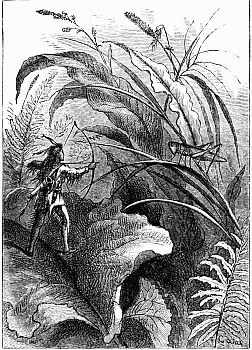 Since the amount of thumbling tales available from Europe and even Africa and Asia has been so overwhelming, I’ve been looking into American Indian tales, which are more sparse in the tiny hero department. I actually have found a thumbling tale type there, which I think is from the Ojibwa people or other nearby nations. There’s Boy-Man or the Little Spirit and the similar character Dais-Imid. Then there’s a whole wealth of suncatcher tales. Here the tiny character may show up as Chakabech (Wyandot), Chapewee (Dogrib) or Tcikabis (Cree or Innu). He lives with his sister, gets mad at the Sun for shrinking his coat and traps the Sun as a result, and then some variety of mouse frees it, shrinking down to its current size as a result. (This connection between tiny characters and the sun also shows up in the Burmese “How Master Thumb Conquered the Sun.” Also, in Tom Thumb’s Folio, published circa 1825, Tom’s small size is attributed to an eclipse. The connection to solar myth is something I’d like to look into further.) However – and this is important – in the Native American tales, the tiny character isn’t really thumb-sized. He’s almost always described as the size of a baby. This means a story based within the realm of possibility – i.e., the story’s less fantastical and the hero could conceivably be a real person with dwarfism. Boy-Man is the one American Indian story most often connected to Tom Thumb. I tracked it back to Jane Johnston Schoolcraft, famous as one of the first female Native American writers. However, the first version I read was by Mary Hazelton Wade. Schoolcraft’s ending feels abrupt, but then so do many oral folktales; Wade’s version, which came later, is almost identical but then provides a moralistic happy ending which feels out of place. I was really confused for a little while there. This is why my most recent find is something I’m a little wary of. I found a Dakota version of the suncatcher tale called “The Little First Man and the Little First Woman,” retold by William M. Cary, which gives me a new Thumbelina character. Here, unlike all the other American Indian stories I’ve found of the same tale type, the characters are tiny. There’s a significant amount of text devoted to describing just how tiny they are. They feast on tiny berries, hunt grasshoppers, etc. It’s imaginative and fanciful, in the style of European (particularly English) thumbling and fairy literature. It just doesn’t feel that much like the typical baby-sized hero of the suncatcher tale, whose size sometimes becomes an afterthought. So on the one hand, I may have finally found an American Indian Thumbelina; on the other hand, I have to track down this story’s history. Also posted on tumblr. Text copyright © Writing in Margins, All Rights Reserved
0 Comments
Leave a Reply. |
About
Researching folktales and fairies, with a focus on common tale types. Archives
July 2024
Categories
All
|
Writing in Margins
 RSS Feed
RSS Feed
